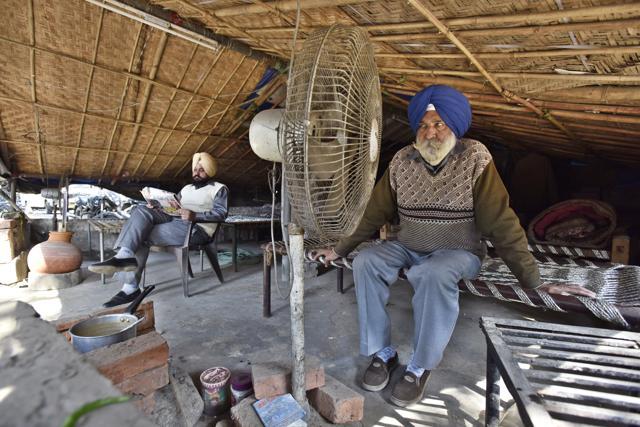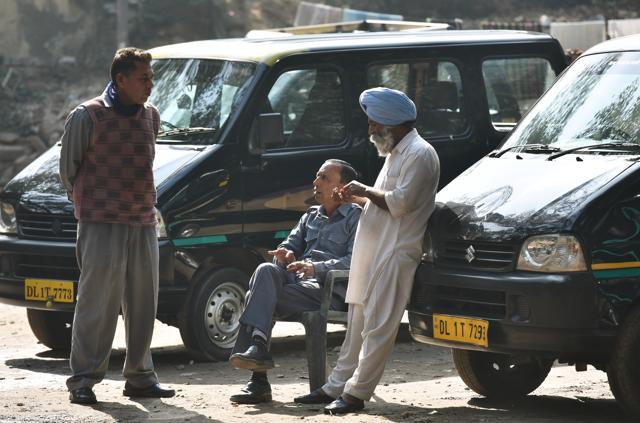Delhi’s once omnipresent kaali-peeli cabs are fading away silently
Most neighbourhood taxi stands in Delhi—there are about 500 of them -- once home to black and yellow taxis and thousands of drivers from Punjab and Himachal Pradesh are now out of business.
A common sight in Delhi not so long ago, the iconic black-and-yellow taxis now appear to be at the fag end of a glorious journey – hit hard by modern cab hailing services and the drivers left with no clue how to revive the business.

At most of Delhi’s 500-odd taxi stands, aged drivers have no work and pass time, recalling the good ol’ days.
“I eat, sleep and work here,” says Avtar Singh, 60, at a stand at Sham Nath Marg in Civil Lines.
From roughly 10,000 a decade ago, the city now has an estimated 6,500 of these taxis – popularly known as the kaalipeelis – but not enough drivers who have switched to working for taxi aggregators such as Ola and Uber.
“Today people feel travelling in the kaali-peeli taxi will lower their status…,” Singh adds.
But Dinesh Kumar, 50, his fellow driver, thinks the reason lies elsewhere. “We just cannot figure out how these new car companies are able to offer such low fares.”
Avtar spends many of his days reclining on a cot inside a hut, reading a newspaper, his hands shivering in the biting January cold. The hut, which serves as a taxi stand at Sham Nath Matg in north Delhi’s Civil Lines, has been his home for 30 years.
“I eat, sleep and work here,” he says, taking his eyes off the newspaper. “But these days there is no work. I have not got any call for the past three days,” he says, pointing to a landline phone on an iron stool at the entrance.
The hut has over half-a-dozen iron trunks that contain clothes of drivers; two fans, a tube light and a bulb hanging from a wooden log. About half-a-dozen black and yellow taxis are parked outside. “I think it is the end of the road for kaali-peelis in Delhi,” says Singh, who came to Delhi from Punjab 35 years ago to drive a taxi.
Read: Should the World Book Fair evolve into Delhi’s JLF?
Most neighbourhood taxi stands in Delhi—there are about 500 of them -- once home to black and yellow taxis and thousands of drivers from Punjab and Himachal Pradesh are now out of business.
While the city still has about 6,600 black and yellow taxis –down from about 10,000 a decade ago –there are not enough drivers. Most young drivers who used to work here have joined online cab hailing services. Most of those still driving the black and yellow taxis are in their 50s and 60s.
Driven to despair by lack of work, they say they have no place in the city’s new cab culture dominated by cab aggregators.
“These days we are lucky if we get one trip a day. There was a time when we did at least six trips a day. Now, only the old-timers who have known us for years call us for station and airport drops. Our business is down by 80 per cent,” says Singh.
“Today people feel travelling in the kaali-peeli taxi will lower their status; they want to travel in a cab that looks like their private car and a driver who looks like their chauffeur,” says Singh.

But Dinesh Kumar, a fellow driver at the 50-year-old stand, differs. “It is all about the fares. We just cannot figure out how these new car companies are able to offer such low fares, almost half of what we offer. We have tried but failed to understand their business model,” says Kumar, who like Singh is waiting for that elusive call from a customer.
The situation is no better at other taxi stands. At the sprawling Ashoka Hotel taxi stand , one of the biggest and the oldest in the city, about 30 black and yellow cabs –- most of them Maruti Eeco -- are parked under towering peepal and neem trees. But there are just a few drivers.
“This place once was crowded with drivers, cleaners and helpers. We have about 33 taxis here but not enough drivers to run them,” says Kanwaljit Singh. “I once owned three taxis, now I have one and have to drive it myself. We would have starved had this taxi stand not been attached to the hotel.”
A lot of his customers, he says, are foreigners who stay in the hotel. “Thankfully, they believe only the black and yellow is the real taxi. They are very fond of Ambassadors but only a few of them are left,” says Kanwaljit.
Until a few years back, most taxi stands used to have black and yellow Ambassadors but now they only have Maruti Eeco – which many drivers say they are forced to buy. “We get permits only for Maruti Eeco. Old people and women find it difficult to sit in this vehicle, which is more of a cargo car,” says Jasbir Singh, a taxi driver -- a sense of anger in his voice. A transport official denied the charge.
“Black and yellow Ambassadors have defined the city’s cab culture, it is the real taxi. But unfortunately, it has become a thing of the past,” says Mohinder Singh, 69, who has been driving taxis in the city for 40 years.

He is not exaggerating. The black and yellow Ambassador taxi was not just a means of getting around in the city, but an integral part of the city’s social history and its mythology much like the yellow cabs in New York City and black cabs in London.
Delhi’s taxi stands and its Ambassador taxis have featured in several books, including William Dalrymple’s City Of Djinns and, most recently, Louise Khurshid’s Travails With Chachi: Conversations With a DLY Taxi Driver, a book that paints a portrait of Delhi seen through the eyes of the Ambassador taxi driver.
One of the few stands in Delhi where one can still see Ambassadors is the Hotel Shangari La taxi stand on Janpath. About a dozen ambassadors are parked here. Unlike other taxi stands, there is no hut and most drivers wait for a call on the loudspeaker from the hotel. Some of them play cards to spend time while others sip tea at a tea shop – a makeshift arrangement with a cot and tarpaulin serving as a roof. Many drivers are sleeping in the back seats of their cars.
Read: Delhi slum turns lab for urban planners, architects, filmmakers testing projects
“Everyone has developed an allergy towards the yellow and black taxi. We are not allowed into offices, apartment or government buildings, though radio taxies and cars belonging to cab hailing companies move in and out with ease. We have suddenly become untouchables,” says Balwinder Singh, a taxi driver who is waiting for a call at the Janpath stand.
Most taxi stands operate on a turn-by–turn basis. “Our turn comes only once in 24 hours, sometimes, even in two days,” says Balwinder.
Sharing the plight of drivers of yellow and black taxis, his fellow driver Balibir Singh says that with the dwindling business, most drivers had to move out of their rented accommodation because they could not afford them, sent their families home and now sleep in the cars.
“Now no one wants to be a driver in Punjab, most new drivers in the city are from UP and Bihar. I plan to move back to Punjab with my Ambassador taxi,” Baliwinder.
In a nutshell
There are about 500 taxi stands and 6,600 black and yellow taxis—a majority of them Maruti-Eeco
There were about 10,000 black and yellow until 2005.
About 300 Ambassadors taxis are left in the city
Black and Yellow cab got a first jolt in 2006 when radio taxis arrived
App-based taxi companies arrived in 2014, putting black and yellow taxis out of business
Stay updated with all top Cities including, Bengaluru, Delhi, Mumbai and more across India. Stay informed on the latest happenings in World News along with Delhi Election 2025 and Delhi Election Result 2025 Live, New Delhi Election Result Live, Kalkaji Election Result Live at Hindustan Times.
Stay updated with all top Cities including, Bengaluru, Delhi, Mumbai and more across India. Stay informed on the latest happenings in World News along with Delhi Election 2025 and Delhi Election Result 2025 Live, New Delhi Election Result Live, Kalkaji Election Result Live at Hindustan Times.





